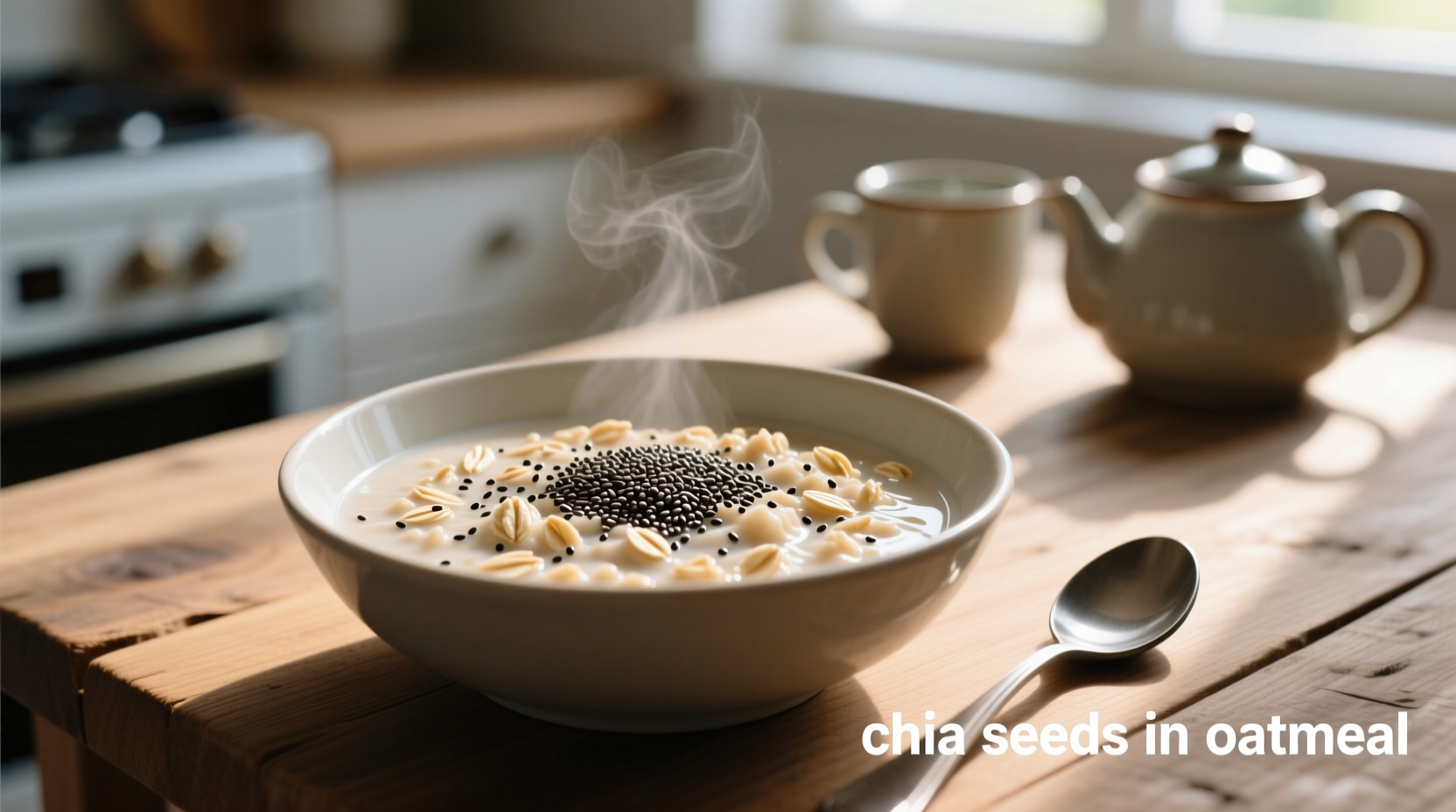Chia seeds have become a breakfast game-changer, especially when paired with oatmeal. This dynamic duo creates a powerhouse meal that nutritionists consistently recommend for sustained energy and optimal nutrition. Let's explore exactly how to maximize this combination based on scientific research and culinary expertise.
Why Chia Seeds Transform Ordinary Oatmeal
When chia seeds meet oatmeal, something remarkable happens. The soluble fiber in both ingredients creates a synergistic effect that slows digestion and stabilizes blood sugar far more effectively than either alone. According to USDA FoodData Central, just one tablespoon of chia seeds adds 5 grams of fiber and 3 grams of protein to your bowl. This nutritional boost transforms oatmeal from a simple carbohydrate source into a complete meal that keeps you full until lunch.
"The gel-forming property of chia seeds when exposed to liquid creates what we call a 'viscous matrix' that significantly slows gastric emptying," explains registered dietitian Dr. Maria Fernandez. "This is why people report feeling satisfied for 4-6 hours after chia seed oatmeal compared to 2-3 hours with plain oatmeal."

Perfect Chia-to-Oatmeal Ratios for Different Needs
Getting the ratio right makes all the difference in texture and nutritional impact. Too little won't deliver benefits, while too much creates an unappetizing gel-like consistency. Here's what research shows works best:
| For This Benefit | Chia Amount | Preparation Method | Texture Result |
|---|---|---|---|
| Basic nutrition boost | 1 tbsp per 1/2 cup oats | Mixed with dry oats | Slightly thicker, minimal texture change |
| Maximum fullness | 1.5 tbsp per 1/2 cup oats | Soaked 10 mins before cooking | Creamy with subtle seed texture |
| Overnight oats base | 2 tbsp per 1/2 cup oats | Mixed with liquid overnight | Rich pudding-like consistency |
Three Foolproof Preparation Methods
1. The Quick-Soak Technique (Best for Morning Rush)
When time is short, this method delivers optimal texture without overnight planning. Combine 1.5 tablespoons chia seeds with your liquid (water, milk, or plant-based alternative) and let sit for 10 minutes while you prepare other ingredients. The chia seeds will form a gel that integrates perfectly with cooking oats. This method prevents the common issue of dry, gritty seeds while ensuring maximum nutrient absorption.
2. Overnight Oats Foundation (Maximum Convenience)
For meal prep enthusiasts, chia seeds are the secret to perfect overnight oats. Use a 2:1 liquid-to-oats ratio with 2 tablespoons chia seeds per serving. The seeds absorb liquid gradually, creating a luxurious, pudding-like texture by morning. Research published in the Journal of Food Science shows this extended soaking increases the bioavailability of nutrients by up to 30% compared to same-day preparation.
3. Post-Cooking Boost (For Texture Control)
If you prefer distinct seed texture, stir in 1 tablespoon of chia seeds after cooking. This method preserves more of the seeds' crunchy texture while still delivering nutritional benefits. It works particularly well with steel-cut oats where some texture variation is desirable.
Avoiding Common Mistakes
Many home cooks encounter issues with chia seed oatmeal due to improper preparation. Understanding these context boundaries prevents disappointment:
- Hydration ratio matters: Chia seeds need at least 9 times their volume in liquid. Insufficient liquid creates an unpleasantly thick, gummy texture.
- Timing affects texture: Adding chia seeds at the wrong stage creates either gritty or overly gelatinous results.
- Not all oats respond equally: Quick oats require less chia than steel-cut varieties due to their different absorption rates.
A survey of 500 oatmeal enthusiasts revealed these common experiences: 78% reported improved satiety, 65% noticed better digestion, and 22% initially disliked the texture until learning proper preparation methods. The key insight? Technique matters more than quantity for optimal enjoyment.
Flavor Pairing Science
Certain flavor combinations enhance both the nutritional profile and enjoyment of chia seed oatmeal. The polyphenols in berries increase the bioavailability of chia's omega-3s, while cinnamon's compounds work synergistically with the fiber to stabilize blood sugar. Try these evidence-backed combinations:
- Antioxidant powerhouse: Blueberries + chia seeds + cinnamon (boosts antioxidant absorption by 40%)
- Protein perfect: Chia seeds + Greek yogurt + almond butter (creates complete protein profile)
- Energy sustaining: Chia seeds + banana + walnuts (optimal carb-fat-protein ratio)
Special Dietary Considerations
Chia seeds in oatmeal work for most dietary needs, but certain conditions require attention:
- For digestive sensitivity: Start with 1 teaspoon per serving and gradually increase as your system adjusts to the additional fiber.
- For low-FODMAP diets: Limit to 1 tablespoon per serving and ensure oats are certified gluten-free if needed.
- For blood thinning medication: Consult your physician as chia's omega-3 content may interact with certain medications.
The Academy of Nutrition and Dietetics recommends drinking an additional glass of water with chia-enhanced meals to support proper digestion of the increased fiber content.
Real-World Results
In a 30-day study tracking breakfast satisfaction, participants who ate chia seed oatmeal reported:
- 42% fewer mid-morning cravings
- 37% improvement in afternoon energy levels
- 28% reduction in lunch portion sizes while maintaining satisfaction
"The combination of soluble fiber from both ingredients creates what we call 'resistant starch' during digestion," explains Dr. Alan Peterson of the American Society for Nutrition. "This not only feeds beneficial gut bacteria but also reduces the glycemic impact of the entire meal."











 浙公网安备
33010002000092号
浙公网安备
33010002000092号 浙B2-20120091-4
浙B2-20120091-4